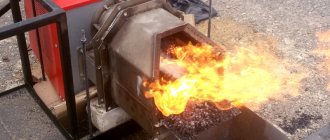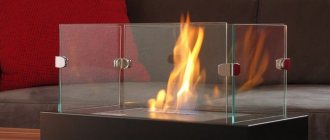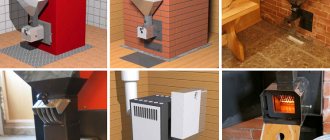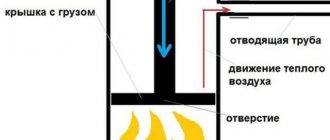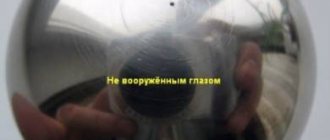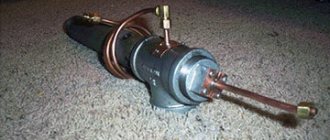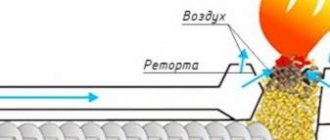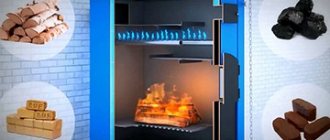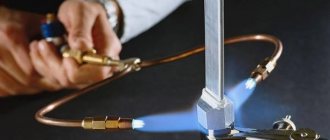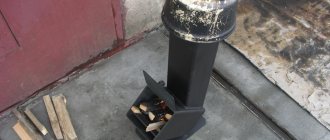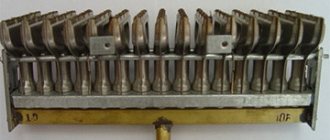Author: Yuriy Fedorovich Kolesnikov, thermal power engineer
Pellet fuel, or simply pellet, as is known, is granular waste from wood processing or agricultural production (straw, husks, etc.) pressed at elevated temperatures. The cost of heating with pellets in countries with abundant natural energy resources may be lower than with coal (excluding places directly adjacent to coal-mining regions). Pellets do not emit harmful fumes like liquid fuel, they are explosion-proof, they stain no more than firewood, but do not require wood harvesting for fuel.
At the same time, pellets are a rather capricious energy carrier; if used incorrectly, they are a fire hazard, and when searching for a DIY pellet burner there is very little useful information; They will show a torch shooting out of a nozzle, and that’s it. Or they give a diagram of a supercharged ceramic burner to a vague description of a gravitational non-volatile burner, or something else like that. This article is intended to fill this gap to some extent.
Fuel pellets and heating boilers with pellet burners
Why do you need a burner?
Pellets are just beginning to conquer the domestic market, but those who have already managed to use this type of good quality fuel choose it. But the question arises: if this is, by and large, ordinary firewood that can be loaded into the firebox, then is it necessary to bother with additional mechanisms. The opinion has a right to exist, but if you do just that, then the combustion of the material will be 80, or even 40%. Everything else will be recycled. In this case, the efficiency is minimal. The burner allows you to increase the combustion of material up to 98%. It is not recommended to use pellets in pyrolysis boilers, as pellets can cause damage that will require boiler maintenance.
The temperature in the burner when burning pellets can reach thousands of degrees Celsius. That is why the question arises about whether it is possible to install a pellet burner in your solid fuel boiler. If you understand well the principle of operation of a pellet burner during assembly and follow clear instructions, then it can be a good addition to the main type of fuel.
Is there any point in doing this?
Often, a person who wants to install such a unit in his home is faced with the question of whether he needs to assemble a pellet stove with his own hands or whether it is best to purchase a ready-made option. It must be remembered that in the first case, a person will be able to create a unit that will fit the existing conditions in all respects, and in the second, he will have to use a structure that is ready for use, but does not take into account the individual characteristics of the room. If doubts are caused by the type of fuel used, then you need to know that pellets are a type of processed wood and agricultural waste, which makes the fuel efficient in terms of heat generation, but economical in cost. Such a homemade stove is environmentally friendly because:
- does not pollute the air;
- does not contain harmful components in vapors;
- do not require special fuel supplies, which eliminates the need to cut down trees.
After weighing all the pros and cons, a person will be able to understand whether it makes sense for him to make such a boiler with his own hands or purchase one already ready for use.
Using pellets
In areas where there is no centralized gas supply, pellets are the most effective and relatively inexpensive fuel. When 1 kg of pellets is burned, thermal energy is released, which is equal to what will be produced after burning half a liter of diesel fuel. The total output power is 5 kW/h. To heat a one-story house in an area where winters are not too severe, it will take approximately 50 kg of pellets per day. The advantage is that they can be filled once every few days, depending on the boiler model. Pellets are placed in a special hopper, from which they are automatically fed into the burner. You will have to service your homemade pellet burner twice a week.
One of the disadvantages of using pellets and pellet burners is the possibility of backdraft. In this case, fire may break out into the bunker. The consequences of such a process will not be the most pleasant, because it will be a good fire. The second nuance that requires special attention in relation to a pellet burner is the amount and intensity of air supply. Pellets are quite light, so an excessive flow can simply blow them off the device, and they will remain unburnt. With less air supply, the pellets also do not burn completely, which leads to the need to clean the burner. For the entire pellet combustion process to be correct, it must have a certain sequence.
To ignite, you must use a special lighter, which is a ceramic rod. It does not affect the pellets with direct fire, but heats up to a temperature of over a thousand degrees. This approach is necessary so that when igniting pellets, the flame does not go into the fuel bunker. The next step is to supply the required amount of air, which is necessary to ensure that the combustion flame is even and stable. Next comes the exit to operating mode. This occurs due to the larger amount of air supplied to the pellet burner. The important factor here is fire without smoke. The stop occurs due to the complete cessation of air supply to the pellet burner.
Pellets: what is it? Detailed fuel characteristics
This raw material is characterized by high energy intensity. It is thanks to this that it has become widespread. When processed, one kilogram of granulated pellets releases approximately 5 kW/h of heat. It follows from this that to organize the heating of a standard private house with average dimensions, you will need about 2 kg of material per hour.
Pellets for the burner are loaded into the device approximately 1-2 times a day. When loading a new portion of raw materials, it is recommended to clean the ash pan from combustion products. Store-bought burners require weekly cleaning, and homemade devices get dirty even faster. It is recommended to clean a home-made device approximately once every 3 days. Otherwise, it will fail quite quickly.
Some burner models do not require loading for 5 days. An example is the APG-42 pellet burner. This model is compatible with Teplodar-Cooper boilers.
The disadvantage of pellet burners is reverse combustion, which is accompanied by the penetration of the pyrolysis zone into the bunker intended for storing and supplying fuel. This entails smoke in the room in which the heating equipment is located, and there is also the possibility of a fire.
Pellets are small granules that are made from wood and used as fuel.
Pellets made from sawdust or any other processed waste can be blown away if there is excess air in the structure, which will lead to the generation of a large amount of waste (ash). The air supply must be clearly regulated, otherwise not only its excess, but also its deficiency can lead to ineffective operation and rapid clogging of the device.
The need for granular fuel in air is determined primarily by the combustion mode
Selecting the right regimen is a primary and very important task. The burner enters the operating mode in 5 stages
Before starting to operate the device, you must become familiar with each phase in more detail.
The first step is to ignite. The burner for a pellet boiler is ignited using a special ceramic lighter rod, which, when turned on, heats up to a very high temperature (900-1100 °C). Devices made by yourself can be ignited with an ordinary torch.
When burning, 1 kg of pellets releases approximately 5 kW/h of heat
The second stage of preparing equipment for operation is launching
It is very important to adjust the correct air supply to adjust the burner flame. Next, the device is overclocked
At this stage the burner enters normal operating mode.
After acceleration, it is necessary to adjust the air so that the correct temperature of the coolant in the return is set inside the device. Then you need to stop the supply of granular fuel and set the required air intensity.
Types of burners
Pellet burners have several types. Reviewing them will allow you to decide which one is best suited for certain conditions. In most cases, a pellet burner requires electricity to operate, which powers the pellet feed mechanisms. Is there anything that can be done if it often disappears?
With forced fence
Such pellet burners are considered one of the best in terms of fire safety; they are used, for example, in Teplodar boilers. But for a burner with such a mechanism you will have to pay a considerable amount, which easily reaches 3 thousand US dollars. Burners with forced intake have several mechanisms through which pellets are supplied. One of them involves the use of a pneumatic system, and the second - an auger. Safety is ensured due to the fact that the channel through which the pellets move goes from bottom to top. Fire is known to move in the opposite direction, so it is unlikely that it will enter the bunker. The pneumatic system for the pellet burner has maximum safety. This is true, because the pellets are supplied in portions and do not remain in the pipe through which they move. For burners with a pneumatic feed system, large hoppers can be installed, which are loaded no more than once a month.
Screw feed mechanisms for pellet burners, for example, Teplodar, consist of two main units. One of them is an auger, which takes pellets from the bunker. He pours the material into another receiver, from which another auger lifts the pellets directly into the burner. In this case, the fire from the burner still reaches the mass. This is due to the fact that the pellets are located along the entire length of the auger. To further secure the mechanism, engineers make a unit that fits the burner from a material that melts and self-extinguishes. It acts as a fuse to cut off the path of fire.
One of the disadvantages of forced-feed pellet mechanisms, such as Telpodar, is their dependence on the availability of electrical energy. If it disappears, the supply of pellets will stop and the heating system may fail. Two electric motors have to be powered. If there are no problems with power fluctuations in your area, then you can purchase additional air boost. It allows you to increase the efficiency of pellet combustion, and accordingly increase the efficiency of the entire system. Mechanisms with a retort are becoming more common. The Fire Chalice has shown to be problematic when it crashes. In this case, the bowl itself became clogged and frequent cleaning was required. In retort burners, the combustion of pellets and pyrolysis gas occurs in the burner itself.
Gravitational
The gravity feeding device of the pellet mechanism is much easier to use. Also, such a device can function without electricity. The bottom line is that the pellets fall under their own weight. Domestic manufacturers of such burners are Pelletron and Begemot. You can start the product from Pelletron and Behemoth by simply adjusting the supply damper and the draft regulator on the chimney. But the disadvantages of the burners from Behemoth and Pelletron are the high probability of ignition of the pellets that are in the bunker. This is due to the fact that the hopper itself is fixed to the hole through which pellets are supplied to the burner. The efficiency of such pellet products is less than that of those with forced feeding.
To solve the fire hazard issue, manufacturers try to install special thermal dampers on such pellet appliances. If a flame escapes from the hearth and moves towards the bunker with pellets, then the heating triggers a special gateway, which simply blocks the movement corridor. Another interesting method of protection is the double grate. It is a simple mechanism. Its upper part approaches the hopper and takes the required number of pellets. After this, it moves to the combustion zone with pellets. The second part at this moment dumps the ash into the receiver, from where it can be cleaned.
DIY assembly
When making a pellet burner with your own hands, it is important to pay special attention to the basket. Often, due to improper implementation, pellets can get stuck. In this case, the combustion process does not follow the required algorithm and the fire returns to the bunker. To eliminate this drawback, you need to look at the upper right part of the figure below. The slot through which the pellets will be supplied does not need to be made solid. It should have holes that are 2 mm smaller than the pellets themselves. It is also worth paying attention to the gap between the bottom of the basket and the back wall. It should be at least 6 mm, but 2 mm smaller than the size of the pellets. The unit where the pellet combustion chamber is separated from the pyrolysis gas combustion chamber must be made with continuous slits. If the burner is designed for a boiler with an area of 150 m2, then the height of the secondary air channels that pass under the bottom of the basket should be 30 mm.
In addition to the basket, a scrupulous approach also requires a bunker in which the pellets will be stored. The problems begin with those pellet bins that are made by eye and according to a loose drawing. On the left in the diagram above are the dimensions and drawings of the hoppers that are used in Pelletrons. With a home area of 150 m2, one such bunker is enough for a day. At the bottom right in the same figure is a drawing and dimensions of the combustion chamber. The basis for them was the Pelletron 15 pellet burner. The corridor through which the secondary air will move is best done in the shape of the letter “L”. This is necessary for better mixing of secondary air with pyrolysis gases. This will increase the efficiency of the installation. The combustion chamber will require a special type of steel that can withstand high temperatures. At the same time, welding it at home can only be done with spot welding, since a conventional welding machine will have difficulty warming it up. You will need sheets with a minimum thickness of 2 mm. An interesting design of a pellet burner is shown in the video below.
The main types of homemade boilers
If you are going to make a long-burning boiler with your own hands, then you will definitely need the information from our review. In the following sections we will tell you how to make a heating unit of one design or another yourself, give several of the easiest schemes, and publish information about the most common long-burning boilers
Let's focus on the last question for now.
The time has come to consider the most current options for long-burning boilers, which we can assemble with our own hands at home. They will all eat wood. As for coal, it is more difficult to obtain, and it also leads to high temperature loads on heating units. In the following sections we will provide drawings of long-burning solid fuel boilers and provide explanatory information.
Long burning mine boiler
We can make the simplest mine boiler with our own hands. It is implemented according to a bottom combustion scheme. The basis of the unit is a capacious loading chamber, which is often called a shaft. Having a vertical design, it allows you to accommodate a large amount of firewood. As they burn, they fall down, and the combustion products are sent through the grate into the ash pan.
If we look at the diagram of a shaft furnace (boiler), we will find that the flame is raging not in the shaft at all, but in the adjacent chamber, from where the resulting heat enters the fire-tube heat exchanger. And the remaining thermal energy is sent to the chimney. The combustion here is long and is determined by the volume of the shaft - after loading a large amount of firewood here, you can safely go to bed.
Pyrolysis boiler
Let's see how a pyrolysis boiler works and how to make this unit with your own hands. The easiest way to explain the operating principle of this unit is to use the example of a potbelly stove. Here we see a volumetric combustion chamber that realizes long-lasting combustion. The resulting combustion products are sent to the afterburner chamber, into which secondary air is supplied. As a result, a large amount of heat is generated. All we have to do is retrofit the potbelly stove with a fire-tube heat exchanger.
There are dozens of drawings of long-burning wood-burning boilers built on the pyrolysis principle of operation. They differ in the location of combustion and afterburning chambers, the presence and absence of blower fans and automation, as well as methods for adjusting the intensity of the wood fuel combustion process. But in general, their operating principle is the same.
Boiler-furnaces Bubafonya
Bubafonya is a stove, and its modification is a water-heating wood-burning boiler with air supply from above, through a pressure piston. We have already written about such stoves more than once in our reviews, now it’s time to talk about units with a heating circuit. To implement the circuit, we can use three schemes:
- Installing a heat exchanger on a chimney is the easiest option;
- Build a continuous water jacket around the boiler body;
- Scald the body of the unit with the pipes through which the coolant will circulate.
Which scheme to choose is up to you. By the way, Bubafonya boilers, due to their spacious chambers, will help to realize long-term combustion lasting up to 24 hours or even more.
Long-burning boilers Bubafonya operate on wood and have an upper combustion scheme.
Boiler-furnaces Buleryan
Initially, Buleryans were (and are) convection-type ovens. They are equipped with powerful convectors, which allow you to warm up a large room in literally 20-25 minutes. Having originally appeared in Canada, these stoves reached Russia, which also boasts a harsh climate (true for some regions). Craftsmen turned stoves into boilers, having worked a little on the design of convectors - now not air, but coolant circulates through them. True, Buleryan boilers cannot boast of long-lasting combustion, since they do not have the largest combustion chambers. Some of them have the property of burning for up to 10-12 hours, some – a little longer. But you still can’t count on 24 hours. But they are characterized by high efficiency and the ability to quickly transfer heat to heating systems.
Design and principle of operation of a pellet burner
Most pellet burners include the following modules:
- Screw conveyor, through which granular fuel is supplied to the combustion chamber;
- Drive motor;
- An electronic controller that monitors fuel combustion parameters and ensures timely adjustments to the operation of the device;
- A special sensor that controls the amount of oxygen in the exhaust gases;
- Corrugated hose to prevent pellets from burning in the hopper when backdraft occurs;
- Combustion chambers with built-in grate;
- A blower fan that supplies the air necessary for efficient combustion of pellets. The amount of air supplied to the combustion chamber depends on the fan rotation speed and is regulated automatically depending on the selected temperature mode;
- An electric heating element that provides automatic ignition of pellets in the combustion chamber.
Operating principle of a pellet burner
From the external hopper, the pellets fall into the loading window of the screw conveyor, which delivers the pellets to the combustion chamber of the burner. The intensity of combustion depends on the amount of fuel entering the combustion chamber, which is directly related to the rotational speed of the drive motor shaft. The engine speed required to ensure the specified temperature regime is regulated by an electronic controller.
An equally important factor for ensuring the stability of the combustion process and complete combustion of fuel is the presence of a sufficient amount of oxygen in the combustion chamber. In pellet modules, air is supplied to the combustion chamber using a special fan, also controlled by an electronic controller.
The coolant temperature adjustment scheme looks like this:
- From the bunker, using a screw conveyor, pellets enter the combustion chamber. At the same time, the fan turns on to provide air supply.
- Based on a signal from the controller, the granules are ignited using an electric heating element;
- As soon as the coolant temperature reaches the set value, the temperature sensor transmits a corresponding signal to the electronic control unit, which switches the device to standby mode;
- If the coolant temperature drops below the programmed value, the temperature sensor again sends a signal to the electronic controller. The automatic control unit turns on the fan, thereby providing additional oxygen flow into the combustion chamber. Excess oxygen leads to an increase in the intensity of the combustion process and the coolant is again heated to the set temperature.
- If the pellets fade in standby mode, the automatic control system sends a corresponding signal to the electric heating element, which ensures automatic ignition.
Despite the fact that the operating principle of a pellet burner is not particularly complicated, the cost of this unit is quite high. To reduce material costs associated with converting a boiler to pellet fuel, some owners of solid fuel heating units make a pellet burner with their own hands. Like any other production, the manufacture of this device begins with the creation of a set of technical documentation, in other words, drawings.
Automation tools
Automation requires a special control unit - the automation of a solid fuel boiler does not have the appropriate capabilities. The auger and blower motors, as well as temperature sensors, are connected to the controller. Receiving a signal from the sensors, the controller will control the operation of the engines, regulating the fuel supply and traction.
The homemade product can also be equipped with a device for automatic ignition and flame control with a photosensor, which are also controlled by the controller. The filling sensor in the fuel pipe will allow you to control the supply of bulk energy.
The use of automation equipment significantly increases the cost of the unit, but makes it as convenient to use as possible.
Automation of boiler operation using a pellet burner
How to draw a drawing of a pellet burner
Before starting to develop drawings, it is necessary to carefully study existing designs. This will allow you to choose the right material and avoid design errors.
The presence of drawings greatly simplifies the manufacturing process of the unit. A set of drawings for a pellet burner must include details of the main components and an assembly drawing of the unit, which must indicate:
- The combustion chamber;
- Container for loading pellets;
- Screw conveyor;
- Blower fan.
When used individually, structural elements can be displayed schematically, without elaboration of specific details, however, overall and connecting dimensions must be indicated with maximum accuracy. Drawings of individual parts must contain comprehensive information about the configuration and material used.
Depending on the type chosen, the unit drawings may have a number of significant differences.
Gravity pellet burner: manufacturing
Making this module yourself will save you from $300 to $2500. In addition, the use of a gravity pellet burner allows you to completely avoid connecting the boiler to the electrical network. In this case, granular fuel enters the combustion chamber directly from the bunker, and the air supply is ensured by natural draft. The intensity of fuel combustion is adjusted by changing the position of the chimney damper.
The disadvantages of such systems include:
- Possibility of ignition of pellets in the bunker when reverse draft occurs;
- Reduced installation efficiency to 85-90%;
- The need to manually adjust the supply of granules and the position of the gate valve.
Materials for making a gravity burner yourself can include:
- A heat-resistant steel pipe with a wall thickness of at least 4 mm is used to make the combustion chamber;
- Sheet structural steel with a thickness of 3 - 4 mm is used to manufacture the mounting flange;
- The main bunker can be welded from sheet steel with a thickness of 2-3 mm.
No. 2. "Teplodar Cooper PRO 36"
Kupper PRO boilers are the most frequently purchased among all Teplodar products. “PRO 36” is a stylish single-circuit boiler for heating large private houses (from 250 sq.m. with a ceiling height of 2.7 m). It runs on coal, wood and briquettes, and if necessary can be converted to use pellets or gas (APG-42 and AGG40-K burners are not included). The compact boiler has good build quality and a lot of other advantages, for example, one of them is a well-thought-out design and extended equipment.
"Kupper PRO 36"
- Steel body 3 mm thick.
- Built-in block of three heating elements with a total power of 9 kW.
- Italian thermomanometer.
- Accessories for boiler cleaning.
- Shiber.
- Stainless steel flame arrester to prevent flames from escaping into the chimney.
- Cast iron bumper to prevent burning coal from spilling.
- Water-cooled grate.
- Developed surface of the water jacket for effective heat removal from all surfaces of the firebox.
- Steel pipe heat exchanger.
- Removable hood inside the heat exchanger for circulation of flue gases.
Can be purchased separately:
- chimney;
- automation for heating elements;
- thermostat;
- draft regulator;
- gas burner.
pros
- Self-cooling combustion chamber door.
- Firebox located at an angle for uniform distribution of fuel and ease of loading.
- Long burning mode. Firewood - up to 8 hours, coal - up to 10.
- 3 year warranty on housing and 1 year on electrical equipment.
Minuses
- The firebox door is not too spacious.
- When using birch firewood as the main fuel, the boiler power may not be enough to heat rooms larger than 250 sq.m.
Fuel burning time
| Coal, hour | Firewood, hour | Firebox volume, l |
| 10 | 8 | 48 |
Characteristics
| Thermal power, kW | Coolant temperature max, °C | Water pressure in the circuit, bar | Efficiency,% |
| 36 | 50 — 95 | 2 | 85 |
Technical specifications
| Weight, kg | W x H x D, mm | Chimney Ø, mm | Heating circuit connection pipe | Heat exchanger jacket volume, l |
| 130 | 505 x 970 x 760 | 150 | 1 ½» | 48 |
Torch pellet burner: manufacturing
Unlike a gravity burner, a flare burner is equipped with a screw conveyor, a fan and an electronic controller, which significantly increases the material costs of manufacturing the unit. Despite this, this design has become widespread due to the following advantages:
- High performance;
- Unpretentiousness to the quality of the granules used;
- Possibility of working in autonomous mode, while the duration of operation is determined solely by the capacity of the fuel bunker;
- High degree of fire safety.
To make a fecal pellet burner with your own hands, you will need to purchase:
- Low-speed electric motor (or two, depending on the design of the feed mechanism);
- A fan that will provide forced air supply to the combustion chamber;
- An electronic controller that monitors changes in coolant temperature and sends corresponding signals to the actuators of the device.
As for the manufacturing process itself, it is much more complicated than the manufacturing process of a gravity burner, since it becomes necessary to install temperature sensors and connect an electronic control system. The materials for manufacturing the unit do not differ from the previous version.
Brief overview of imported products
A foreign alternative to domestic products is the Kiturami pellet burner, the list of its characteristics is as follows:
- power range – from 8 to 33 kW;
- Product efficiency is up to 95%, the overall efficiency value depends on the design of the boiler;
- remote controller;
- sensors for temperature, water level, overheating, overflow of auger with granules;
- self-cleaning grate.
The disadvantages of this device are its high cost and dependence on the reliability of the power supply. Otherwise, the product is quite reliable and does not cause any complaints; it is equipped with DRAGON KRP solid fuel installations.
Ferroli pellet burner
The Ferroli Sun P7 and Sun P12 pellet burner, which is installed on solid fuel units BUDERUS and SFL, is no less highly reliable. Maximum power is 34 and 55 kW, respectively, the set of options is the same as that of the previous manufacturer. The fan is a centrifugal type that provides a sufficient amount of air.
The imported Pelltech pellet burner has a wide range of available capacities, from 20 kW (Pelltech PV-20) to 1 MW (Pelltech PV-1000). It works well in conjunction with VIESSMANN boilers; the latter’s delivery package includes, as an option, a gas cleaning unit with a smoke exhauster; it is needed for installations with a power of over 200 kW.
Retort pellet burner: manufacturing
The supply of granular fuel in such devices, as well as in flare devices, is carried out using a screw conveyor. The difference is that the granules are fed from below. The air required for combustion is forced through special holes in the walls of the retort. For the effective operation of such a device, a controller is required that promptly responds to changes in coolant temperature and makes the necessary adjustments to the operation of the auger and fan.
Unlike flare devices, the flame in a retort pellet burner is directed upward, so the design of the heat exchanger for these units is very different. The disadvantages of retort systems include:
- Possibility of frequent clogging of the air duct openings, leading to attenuation of the device;
- The need to manually clean the retort from combustion products and granulated fuel residues;
- No gaps in the supply of granules. If reverse draft occurs, the possibility of ignition of the pellets in the bunker remains.
Heat-resistant steel and cast iron can be used as the material for the bowl. In some models, the retort can be made of ceramic concrete or fireclay.
The complexity of manufacturing such a device at home is quite high, since in addition to plumbing and welding work, skills in connecting electronic control systems will be required.
Automation methods
The ratio of fuel and air supply to the combustion chamber must be adjusted, otherwise the operation of the heating equipment will be unstable or constantly occur at high power.
The easiest way to change the speed of the fan and screw motor is to install a simple regulator. But in this case, there will be an added need for regular supervision and adjustment of the equipment, taking into account the ambient temperature and coolant. Setting up a heating system with your own hands consists of selecting, in different operating modes, such a ratio of air and fuel supply, during which the flame will be stable and even. This can only be achieved by automating the operation of the boiler.
First you need to purchase an electronic control unit. If the boiler is already equipped with this device, then you need to carefully study the possibilities of its use. Typically, controllers from leading manufacturers have free control contacts where electric auger and fan motors can be connected. In this case, taking into account the sensor readings, the controller will begin to increase or decrease the fuel supply and regulate the fan speed.
In terms of ignition and flame control, the burner can also be automated. It is necessary to purchase a photosensor, as well as an electronic filament element. The latter turns on at the very beginning, igniting the pellets, and the photosensor, when a persistent flame appears, will notify the controller, which will turn off the incandescent element.
A filling sensor is installed on the pipe; its main task is to send a signal to the electronic control panel if the auger is filled with pellets in order to complete the fuel supply. All these automation methods make it possible to burn fuel efficiently and create comfort during heating boiler maintenance. But there are also certain disadvantages:
- The cost of manufacturing the burner increases significantly.
- The electronic unit of the heating boiler included in the kit is usually not suitable for simultaneous operation with devices for controlling and igniting the burner; in this case, it is necessary to purchase a new one.
- The burner cannot be connected to any controller.
Do-it-yourself automation for a pellet burner
The most difficult stage in the manufacture of a pellet burner is the manufacture and installation of electronic control modules. If we consider this issue from a theoretical point of view, if you have special knowledge, you can make a controller yourself, but in practice this is almost impossible. In addition, the cost of components will reduce cost savings to a minimum, and the result may be very questionable. Therefore, even if you make your own burners, controller, sensors and other automation, it is better to purchase them in a specialized store.
For efficient operation of the burner, the automation must provide:
- Dosage of pellet supply and control of the screw conveyor;
- Automatic ignition and extinguishing;
- Adjusting the air supply by changing the fan speed;
- Estimation of the amount of coolant in the heating circuit;
- Control of coolant temperature in the boiler water jacket;
- Assessment of draft parameters in the chimney.
Failure to comply with even one of these conditions can lead to failure of not only the heating boiler, but also the entire heating system.
Making a pellet burner is a labor-intensive and responsible process, however, if you have the necessary knowledge and equipment, it is quite possible to make such a device yourself. Particular attention should be paid to the selection of parameters and installation of electronic control systems; the efficiency of the boiler will depend on the correctness of their operation.
The unique smell of natural wood, a clean and decorated room in a modern style - this is exactly what a boiler room in a house can look like if you choose the right equipment. Innovative heat-generating equipment that will create the described conditions indoors is a pellet boiler or an automatic pellet burner, running on special fuel pellets, which are created from waste from agro-industrial or woodworking production.
If just a few years ago pellet installations were used in only 20% of homes in Europe, now the figure has increased to 70%. The use of pellet boilers and burners is the most beneficial option for heating a living space from an environmental and economic point of view. Today we will talk about the operating principles of the equipment, its advantages and disadvantages, and also consider a diagram for making a pellet burner with your own hands.
Positive Features
The described equipment has an automatic ignition system and is also fireproof. The consumer will have the opportunity to reduce costs due to the insignificant cost of pellets. Among other things, you will not need to spend additional money on maintenance. You can count on a high efficiency, and the service life of such equipment is 20 years, which will depend on the correct manufacturing and operational features. The device does not depend on central heating sources and tariffs for such services.
About the pellet burner
A pellet burner is a special heating device that produces heat by burning pellets or fuel granules in a boiler. In some cases, these burners use unnecessary dry grain.
There are manual and automatic burners; in automatic burners, fuel is supplied to the combustion hopper using a special auger, and the entire process is controlled by sensors, due to which the device requires minimal control from the user. Pellet burners have found their use not only in everyday life, but also in industry. They are used for space heating, water heating and to meet a number of other needs.
Pellets, or fuel granules, are a special solid fuel that is obtained from wood or agricultural waste by pressing and granulating under high temperatures.
Pellets are an environmentally friendly type of fuel, since when they are burned, the same amount of carbon dioxide is released into the atmosphere as is formed during the natural decomposition of wood
In countries where agriculture and the woodworking industry occupy leading positions, the cost of pellet fuel is much lower than that of coal. The only exceptions are those regions in close proximity to which coal mining enterprises are located.
When burning pellets, hazardous fumes are not released, as happens when burning liquid fuel.
Introduction
More and more people understand that granulated herbal mixtures are much healthier for animals, and granulated wood provides several times more heat than ordinary firewood.
Buying a granulator is not always possible, and then craftsmen have the opportunity to train their brains and make a home masterpiece, from which the soul will rejoice for a very long time.
If, after reading this, you decide that it is more profitable for you to buy a press, then contact me at “SUPPORT”. Today there are lines or separate presses both for home use and for small-scale production.
If you contact me, I will tell you which press is best for you to choose, we will select the productivity and even you will be able to visit a real pellet plant for FREE. More details about my services can be found in the “SERVICES” section. I also have an interesting, inexpensive book, which you can find out about in the “MY BOOKS” section.
Principle of operation
All pellet installations that can be purchased in the store are equipped with additional components:
- Auger – supplies fuel from the bunker to the combustion chamber;
- Controllers for automating the work process;
- Bunker – the place where the fuel is located before being supplied to the combustion chamber;
- A lambda probe is a special sensor that monitors the oxygen content in smoke chambers and independently controls the fuel combustion process depending on conditions.
The pellet burner must be protected with a plastic corrugated pipe. It acts as a fuse when reverse draft occurs. If the fire begins to move towards the bunker, the pipe burns out, preventing the flame from spreading.
Additionally, a fan is used, which enhances the combustion of pellets by pumping air, as well as a thermoelectric heater, which allows the fuel to be ignited without human intervention.
In automated devices, pellets are fed into the combustion chamber automatically; a person is only required to monitor the amount of fuel in the bunker. The need to supply fuel to the combustion chamber is determined using temperature sensors (they can monitor the air temperature in the room, the water temperature, or any other environmental indicators depending on the operating mode of the equipment).
The required temperature of the coolant is set by the user, all further increases and decreases are controlled using automated equipment. As soon as the temperature reaches the set level, the burner begins to operate in standby mode (the pellets do not go out, they begin to smolder). If the temperature, on the contrary, drops, the controller activates the built-in fan. Under the influence of air, the pellets flare up and the burner goes into operating mode. If during downtime the pellets go out for any reason, the heating element is activated, which re-ignites.
Description of operating modes
The very principle of operation of a pellet burner is as follows: a portion of fuel enters the chamber, it is ignited and the minimum air supply is turned on. As the fuel burns and the chamber warms up, more air is forced in. As a result, a stable, even flame appears, heating the heat exchanger with water. In factory burner devices, the process is fully automated, ignition is provided by an electric incandescent element, and its operation is controlled by a photosensor. The amount of air and pellets supplied to the chamber is regulated by an electronic unit, receiving signals from temperature and pressure sensors. A diagram of a pellet burner will help you understand how the device works.
Fuel in the form of wood pellets or seed husks can be supplied to the pellet burner auger in various ways:
It is not difficult to select materials for making the device. Considering the temperature regime of the combustion chamber, it is better to take a pipe made of heat-resistant steel with a wall thickness of at least 4 mm. The flange plate, with which a homemade pellet burner is attached to the body of the boiler installation, can be made of ordinary quality steel with a thickness of 3 mm. The feed conveyor can be purchased assembled, or you can make it yourself from an ordinary pipe by placing a screw in it. For rotation, a low-speed electric motor, gearbox and bearings are selected. The fan must be purchased and fixed to the plate, preparing a seat for it. The plate itself must be made by studying the drawings of the pellet burner, and depending on the design of the boiler door.
Pellet burner parts
Device
Any burner has one goal - creating a powerful flame to heat the air or water jacket of the boiler. At the same time, the combustion power itself can be adjusted independently.
A pellet burner has similar goals. The device is a wind tunnel into which solid fuel is supplied and air is pumped for combustion. Fuel is supplied to the pipe using a special screw-type conveyor. The fuel itself is located in the loading hopper before combustion. The bunker can have a different volume, and it depends on the volume how long the burner can burn on its own without human intervention (adding fuel).
Pellet burner structure: 1 - The pellet enters the burner under the influence of gravity; 2 - Air enters the burner due to the vacuum created by the draft of the chimney; 3 - Pellet combustion occurs in the combustion chamber, which is called the “basket”; 4 - Due to the high temperature, thermal decomposition of wood occurs in the basket, which forms a flow of flammable gases; 5 - A secondary air flow passes under the basket; 6 - In the burner nozzle, the flow of combustible gases and secondary air mixes, forming a torch; 7 - Solid combustion products are ejected from the burner into the ash pan of the boiler or furnace by a stream of secondary air; 8 - Ventilation of the supply channel does not allow hot gases to diffuse up the channel and destroy the pellets, ensuring a stable supply of pellets.
Air is forced into the combustion zone by means of a fan.
The combustion chamber in the burner can be round or rectangular. Round burners are the most common due to their ease of manufacture. A pipe connection is attached to the outside of the combustion chamber, through which fuel is supplied from the conveyor.
The design also includes an ash pit in which combustion waste accumulates. During the combustion of pellets, a little ash is formed, so you need to clean the ash pan no more than once a week when the burner is actively used.
There are several types of pellet burners, each of which has its own advantages and disadvantages.
Flare type
Initially, the device was used to generate heat by burning grain, but later it was converted to burn solid compressed fuel.
Side view of a flare type burner
- Small overall dimensions;
- Can be used in conjunction with boilers with a small combustion chamber;
- Simplified operation;
- Increased reliability;
- You can burn low quality pellets.
- Low power compared to other burners;
- The flame is directed horizontally, which is why it heats the boiler locally.
Volumetric type
Unlike the previous model, they have increased power and high efficiency. The disadvantages of the device include a complicated design, large overall dimensions, and dependence on the quality of the pellets used.
General view of the volumetric combustion burner
Fireplace
Burning pellets in a fireplace burner
Such designs are mainly used in domestic conditions, installed in fireplaces and boilers. The operating principle of the device is as follows: pellets fall into a special bowl, where they are burned under the influence of air supplied from below.
The disadvantages of the model include the size of the device and the need for precise adjustments for proper combustion.
Advantages and disadvantages
The equipment has a number of advantages:
- Pellets are a safe fuel compared to gas and electricity;
- Allows you to significantly reduce space heating costs compared to using electric boilers. At the same time, pellet installations are more expensive than gas equipment, but do not forget that it is not always possible to supply gas and purchase gas cylinders;
- Homemade installations guarantee high efficiency - 95%. Some store installations are over 97%;
- They are used not only for heating the room, but also for producing hot water;
- There are no rules for transporting and storing fuel. When near a person, pellets do not cause allergic reactions, and there are no toxic fumes when burning;
- Fuel is available for purchase. Equipment owners complained about the lack of fuel and the need to prepare a supply of pellets from the winter when the devices appeared; now there is no need to store a large volume of pellets at home; if necessary, they can be bought everywhere;
- The price of pellets is on average at the same level, unlike gas and electricity, the tariffs for which periodically experience seasonal fluctuations;
- Installation of the device does not require special skills, and there is no need to coordinate the installation with authorized bodies;
- After combustion of pellets, natural mineral ash is formed, which does not require special rules for disposal.
Along with the advantages of such equipment, there are also a number of disadvantages:
- High cost of ready-made store equipment. Despite the popularization of devices in recent years and some reduction in prices, pellet boilers are still more expensive than gas or electric equipment of similar power;
- The equipment requires constant maintenance (especially outdated models). The user will have to clean the ash pan and heat exchanger from accumulated ash once a week. In modern models, cleaning is provided at an automatic level;
- In the absence of automatic fuel supply, the user has to load pellets into the bunker manually;
- It is necessary to ensure minimum humidity conditions in the rooms in which pellets will be stored awaiting use;
- Imported equipment is practically not designed for the conditions of the harsh domestic winter, as a result of which breakdowns and malfunctions often occur;
- In remote areas, fuel for the winter still has to be stored due to the instability of supplies.
